Mormon War may refer to:
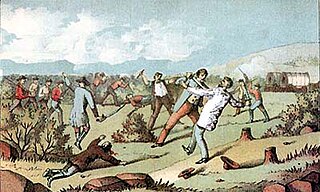
The Danites were a fraternal organization founded by Latter Day Saint members in June 1838, in the town of Far West, Caldwell County, Missouri. During their period of organization in Missouri, the Danites operated as a vigilante group and took a central role in the events of the 1838 Mormon War. There is no evidence that the Danites existed after 1838. However, they remained an important part of Mormon and non-Mormon folklore, polemics, and propaganda for the remainder of the 19th century, waning in ideological prominence after Utah gained statehood. Notwithstanding public excommunications of Danite leaders by the Church and both public and private statements from Joseph Smith referring to the band as being both evil in nature and a "secret combination", the nature and scope of the organization and the degree to which it was officially connected to the Church of Jesus Christ of Latter Day Saints are a matter of some dispute among historians. Earlier in the band's existence, Joseph Smith appeared to endorse the group's actions, but later turned against them as violence increased and the actions of the Danites inspired a hysteria in Missouri that eventually led to the Extermination Order. According to an essay on the website of the Church of Jesus Christ of Latter-day Saints, "Historians generally concur that Joseph Smith approved of the Danites but that he probably was not briefed on all their plans and likely did not sanction the full range of their activities."
The Utah War (1857–1858), also known as the Utah Expedition, the Utah Campaign, Buchanan's Blunder, the Mormon War, or the Mormon Rebellion, was an armed confrontation between Mormon settlers in the Utah Territory and the armed forces of the US government. The confrontation lasted from May 1857 to July 1858. There were some casualties, most of which were non-Mormon civilians. The war had no notable military battles.

Adam-ondi-Ahman is a historic site in Daviess County, Missouri, about five miles south of Jameson. It is located along the east bluffs above the Grand River. According to the teachings of the Church of Jesus Christ of Latter-day Saints, it is the site where Adam and Eve lived after being expelled from the Garden of Eden. It teaches that the place will be a gathering spot for a meeting of the priesthood leadership, including prophets of all ages and other righteous people, prior to the Second Coming of Jesus Christ.
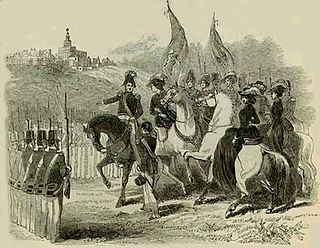
The Nauvoo Legion was a state-authorized militia of the city of Nauvoo, Illinois, United States. With growing antagonism from surrounding settlements it came to have as its main function the defense of Nauvoo, and surrounding Latter Day Saint areas of settlement.

The 1838 Mormon War, also known as the Missouri Mormon War, was a conflict between Mormons and non-Mormons in Missouri from August to November 1838, the first of the three "Mormon Wars".
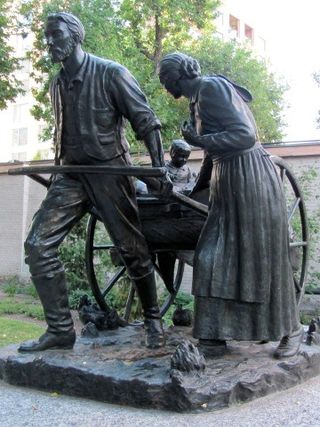
The Mormon pioneers were members of the Church of Jesus Christ of Latter-day Saints, also known as Latter Day Saints, who migrated beginning in the mid-1840s until the late-1860s across the United States from the Midwest to the Salt Lake Valley in what is today the U.S. state of Utah. At the time of the planning of the exodus in 1846, the territory was part of the Republic of Mexico, with which the U.S. soon went to war over a border dispute left unresolved after the annexation of Texas. The Salt Lake Valley became American territory as a result of this war.

Missouri Executive Order 44, commonly known as the Mormon Extermination Order, was an executive order issued on October 27, 1838, by the then Governor of Missouri, Lilburn Boggs. The order was issued in the aftermath of the Battle of Crooked River, a clash between Mormons and a unit of the Missouri State Militia in northern Ray County, Missouri, during the 1838 Mormon War. Claiming that the Mormons had committed open and avowed defiance of the law and had made war upon the people of Missouri, Governor Boggs directed that "the Mormons must be treated as enemies, and must be exterminated or driven from the State if necessary for the public peace—their outrages are beyond all description". The Militia and other state authorities—General John B. Clark, among them—used the executive order to violently expel the Mormons from their lands in the state following their capitulation, which in turn led to their forced migration to Nauvoo, Illinois.

Lyman Wight was an early leader in the Latter Day Saint movement. He was the leader of the Latter Day Saints in Daviess County, Missouri, in 1838. In 1841, he was ordained a member of the Quorum of the Twelve Apostles. After the death of Joseph Smith resulted in a succession crisis, Wight led his own break-off group of Latter Day Saints to Texas, where they created a settlement. While in Texas, Wight broke with the main body of the group led by Brigham Young. Wight was ordained president of his own church, but he later sided with the claims of William Smith, and eventually of Joseph Smith III. After his death, most of the "Wightites" joined with the Reorganized Church of Jesus Christ of Latter Day Saints.
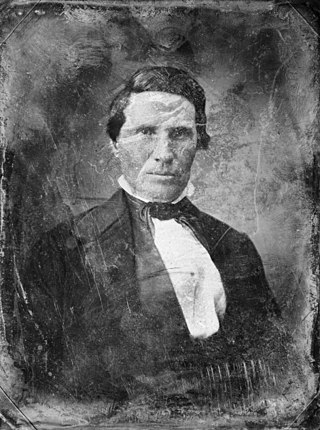
Alexander William Doniphan was a 19th-century American attorney, soldier and politician from Missouri who is best known today as the man who prevented the summary execution of Joseph Smith, founder of the Church of Jesus Christ of Latter Day Saints, at the close of the 1838 Mormon War in that state. He also achieved renown as a leader of American troops during the Mexican–American War, as the author of a legal code that still forms the basis of New Mexico's Bill of Rights, and as a successful defense attorney in the Missouri towns of Liberty, Richmond and Independence.

The Haun’s Mill Massacre occurred on October 30, 1838, when a mob/militia unit from Livingston County, Missouri, attacked a Mormon settlement in eastern Caldwell County, Missouri, after the Battle of Crooked River. By far the bloodiest event in the 1838 Mormon War in Missouri, it has long been remembered by the members of the Latter Day Saint movement. While the spelling "Haun" is common when referring to the massacre or the mill where it occurred, the mill's owner used the spelling "Hawn" in legal documents.
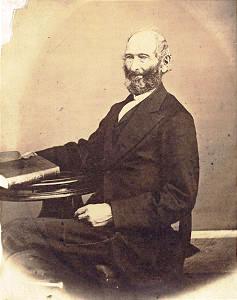
John Whitmer was an early leader in the Latter Day Saint movement. He was one of the Eight Witnesses of the Book of Mormon's golden plates. Whitmer was also the first official Church Historian and a member of the presidency of the church in Missouri from 1834 to 1838.

William Wines Phelps was an early leader of the Latter Day Saint movement. He printed the first edition of the Book of Commandments that became a standard work of the church and wrote numerous hymns, some of which are included in the current version of the Church of Jesus Christ of Latter-day Saints' hymnal. He was at times both close to and at odds with church leadership. He testified against Joseph Smith, providing evidence that helped persuade authorities to arrest Smith. He was excommunicated three times and rejoined the church each time. He was a ghostwriter for Smith. Phelps was called by Smith to serve as assistant president of the church in Missouri and as a member of the Council of Fifty. After Smith's death, Phelps supported Brigham Young, who was the church's new president.
Within the Latter Day Saint movement, Zion is often used to connote an association of the righteous. This association would practice a form of communitarian economics called the United Order meant to ensure that all members maintained an acceptable quality of life, class distinctions were minimized, and group unity achieved.
John Corrill was an early member and leader of the Church of Jesus Christ of Latter Day Saints, and an elected representative in the Missouri State Legislature. He was prominently involved in the Mormon conflicts in Missouri before leaving the church in 1839 and publishing A Brief History of the Church of Christ of Latter Day Saints .
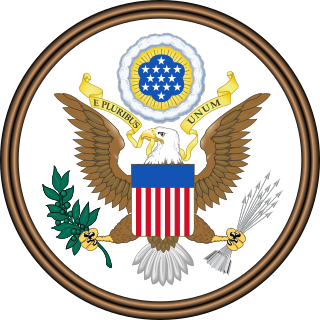
The Morrill Anti-Bigamy Act was a federal enactment of the United States Congress that was signed into law on July 1, 1862, by President Abraham Lincoln. Sponsored by Justin Smith Morrill of Vermont, the act banned bigamy in federal territories such as Utah and limited church and non-profit ownership in any territory of the United States to $50,000.
Mormons have both used and been subjected to significant violence throughout much of the religion's history. In the early history of the United States, violence was used as a form of control. Mormons were violently persecuted and pushed from Ohio to Missouri, from Missouri to Illinois and from Illinois, they were pushed west to the Utah Territory. There were incidents of massacre, home burning and pillaging, followed by the death of their prophet, Joseph Smith. Smith died from multiple gunshot wounds from a lynch mob at a jail in Carthage, Illinois; Smith had defended himself with a small pistol smuggled to him by church leader Cyrus Wheelock and he was then shot while trying to flee from a window. There were also notable incidents in which Mormons perpetrated violence. Under the direction of Mormon prophets and apostles, the Mormon burned and looted Davies County, attacked and killed a member of the Missouri state militia, and carried out an extermination order on the Timpanogos. Other Mormon leaders led the Mountain Meadows Massacre, Battle Creek massacre, and Circleville Massacre. Mormons have also been a major part in several wars, including the 1838 Mormon War, Walker War and Black Hawk War.

Henry Harriman was one of the First Seven Presidents of the Seventy of the Church of Jesus Christ of Latter Day Saints from 1838 until his death. The town of Herriman, Utah was named after him.

The Church of Jesus Christ of Latter-day Saints in Missouri refers to the Church of Jesus Christ of Latter-day Saints and its members in Missouri. The official church membership as a percentage of general population was 1.14% in 2014. According to the 2014 Pew Forum on Religion & Public Life survey, roughly 1% of Missourians self-identify themselves most closely with The Church of Jesus Christ of Latter-day Saints. The LDS Church is the 8th largest denomination in Missouri.
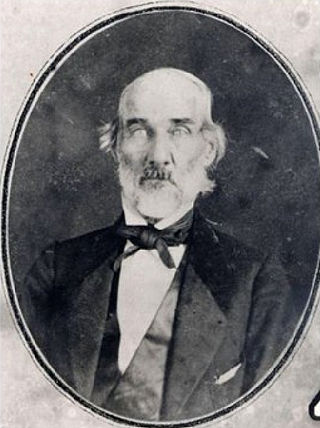
Samuel Bogart was an itinerant Methodist minister and militia captain from Ray County, Missouri who played a prominent role in the 1838 Missouri Mormon War before later moving to Collin County, Texas, where he became a Texas Ranger and a member of the Texas State Legislature. He is best remembered, however, for his role in leading opposition to Mormon settlers in northwestern Missouri, and for the active role he took in operations against them in the fall of 1838. These operations led to the expulsion of nearly all Mormons from the state following the issuance of Governor Lilburn Boggs' infamous Extermination Order in October of that year.
The Kirtland Camp was a migration company made up of several hundred Latter-day Saints that traveled from Kirtland, Ohio to northern Missouri starting in the fall of 1831. The group was led by the third-highest ranking priesthood quorum in the hierarchy of the Church of Jesus Christ of Latter-day Saints: the First Seven Presidents of the Seventies. Those who stayed with the main company to the end of the journey settled in Mormon communities in Daviess County, Missouri during the 1838 Mormon War and shortly afterwards were forced to evacuate the area due to conflicts with non-Mormon settlers in the region.